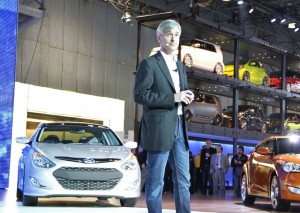Forced to restate mileage claims after a government audit, Hyundai and its Korean sibling Kia could be in a world of financial hurt – even as they struggle to overcome the potential damage to their image which, in recent years, has put an emphasis on delivering industry benchmark fuel economy.
With several lawsuits already filed and more likely, Moody’s Investors Service has warned that the ultimate cost to the two brands could reach $100 million in the U.S. While other analysts aren’t ready to embrace that specific number, there is clear consensus the damage may be costly and long-lasting.
Together, Hyundai and Kia “will incur additional annual costs of about $100 million until the affected models are largely scrapped,” warned the ratings agency in a new report. It also noted that despite the size of that figure, it comes to less than 1% of the Korean maker’s total earnings.
Both Hyundai and Kia have put an emphasis on fuel economy in recent years, together advertising more than a half-dozen models delivering at least 40 mpg highway mileage. Or so they claimed until last week before an audit by the Environmental Protection Agency, the federal agency overseeing fuel economy standards and vehicle testing.
Spurred by complaints about the real world mileage some Hyundai and Kia products produce, the EPA conducted an audit showing the figures for 13 models – accounting for the sale of 900,000 vehicles in the U.S. since 2010 – were overstated by anywhere from one to six miles per gallon.
(EPA may expand mileage probe; could snare other makers. Click Here for that update.)
The Koreans insist the mileage gap was not intentional but the result of errors in their own testing procedures. After issuing a mea culpa they also announced a plan to reimburse owners based on the added cost of fuel for their vehicles – adding in another 15% to cover the burden of having to bring those vehicles in to Hyundai and Kia dealers to check their odometers.
For someone clocking 15,000 a year, the result could be a debit card of more than $80 a year with some models – Hyundai and Kia promising to keep issuing reimbursements as long as the car is in the original owner’s hands. Considering the length of time many buyers today maintain their vehicles, that could mean eventually payouts of as much as $500 or more per affected automobile. And if that were the case with all 900.000 vehicles, the debit card bill might approach $500 million.
“Our focus is on making it right for the customers. We’re honestly not so focused on that cost,” Hyundai Motor America CEO John Krafcik asserted during a media conference call last Friday.
In reality, the typical payout is expected to be far less. Indeed, cautions analyst Jim Hall, of 2953 Analytics, “For many owners, punching two hours out of their day to go to a dealer for a $60 debit card won’t be worth it.”
For the moment, Hall insisted trying to put a price tag on the fiasco would be like “trying to pull numbers out of the air,” though he agreed, “it is going to cost them.”
And other factors in the long-term payout could dwarf the cost of handing out debit cards to owners of vehicles like the 2012 Kia Soul – whose mileage rating has been cut by 6 mpg.
There will almost certainly be fines, for one thing, from the EPA. And the Federal Trade Commission could weigh in if it determined the makers violated advertising rules.
Then there are the legal bills. Even before last week’s disclosure, Hyundai had been sued by a consumer group that had insisted the maker’s mileage claims were inflated. This week, three Hyundai owners in Ohio have filed another lawsuit seeking to recover damages and legal fees. It’s almost certain more lawsuits will follow and may very likely morph into one or more national class action cases. If successful, the bill for the Koreans could climb into the $10s, even $100s, of millions.
But analyst Hall warns that the for-now “incalculable cost” could be the way the flap impacts Hyundai and Kia’s image and consideration factor. One may never get a clear sense of the damage to their brand images, as there’s no direct correlation between image and sales. But if mileage-gate reduces the number of potential buyers who consider their products, that will soon become obvious – and translate into lower sales.
That may be where the real numbers start to add up.

